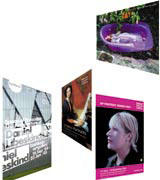Flat formula
Instead of producing graphics that jump out at potential visitors, most of London’s galleries and museums produce communications that conform to the same lacklustre style, says Michael Johnson

I wish I could report that the same malaise is afflicting the rest of the world, but it’s not. Take the fabulous work being done in Japan by Jonathan Barnbrook for the Mori Art Museum/ Roppongi Hills complex in Tokyo: here is a great client going out on a limb to appoint a tiny London company to supply the work for Tokyo’s most talked about bit of real estate since the Park Hyatt sprung up in Tokyo’s Shinjuku district. My own company has spent the past five years creating hundreds of pieces of work for La Villette in Paris, which I’d like to think has supplied what each separate event needed – its own identity, within a clear framework. Studio Dumbar has spent decades showing how cultural identities can be alive, rather than stifling strategic straightjackets.
But in the UK, it seems that conservatism still holds sway. Roy Strong once likened the curator-driven atmosphere of the Victoria & Albert Museum to a baronial fiefdom, so it comes as no surprise that all its identity review could propose was to move the logo out of the corner and specify a sans serif typeface, just like everyone else.
What continues to astound me is that in the face of ever-greater competition for visitors from London’s multifarious attractions, some still cling to the idea that every new poster or exhibition starts with a blank sheet of paper. There’s often no attempt at house style, apart from tacking a logo on to the corner. So one National Portrait poster looks equally different from the last, but they’re all equally dull, which does a great and fascinating gallery (with great exhibitions) a huge disservice.
When shown ideas that would ‘glue’ their communications together, they run a mile. We’ve had some hilarious moments in the boardrooms of London as we unfurl ideas that would give events cohesion. The horror on people’s faces when confronted with genuine house style is truly astounding, just as it is when they’re shown ideas that might make people think about what they’re exhibiting.
Recently we proposed, in collaboration with ad agency Hooper Galton, ideas to Tate Britain about how its museum could be where British art ‘came alive’, and illustrated it with images of families recreating famous British art landmarks in their back gardens after a visit.
So Ophelia became a drowning Barbie, and Richard Long became the contents of the garden shed. What did they run? An enlargement of Tracy Emin’s tent with the words ‘Great British Art’ next to it. Hardly likely to challenge the brain cells of your average London commuter (and equally unlikely to fix the huge drop in attendance Tate Britain has suffered since the opening of Tate Modern).
Most cultural centres continue to peddle the stock solution. You know the one: bleed picture, reversed out headline, sponsor logos in one corner, institution’s logo in the other. Very simple to do, of course, but equally simple to forget. And also prone to failing the simple ‘thumb’ test. This is where you stand in front of a gallery poster, or hold one of its leaflets, stick your thumb over the logo then ask yourself, whose poster is it? Try that 20 times with a pile of leaflets and you’ll soon be as concerned as I am with the state of British cultural graphics.
Maybe there’s some hope. I’m encouraged by North’s muscular work for the Barbican Art Gallery. The typographic scheme really powers out of recent posters for the Libeskind show and Communicate, but the most interesting development is with the Barbican logo, itself only a few years old. This slightly predictable, lower-case-type-in-circle-with-missing-dot-thing that Lloyd Northover originally supplied has been quietly changed by North to Futura to match the more recent creative work.
Maybe it’s a sign that our institutions will finally get the graphic images that their programming suggests. Maybe the new norm for this sector will be schemes where you can almost feel the energy, exuberance and excitement. Maybe. But I fear my thumbs will be needed for testing for some time yet.
Michael Johnson is principal at Johnson Banks
-
Post a comment




